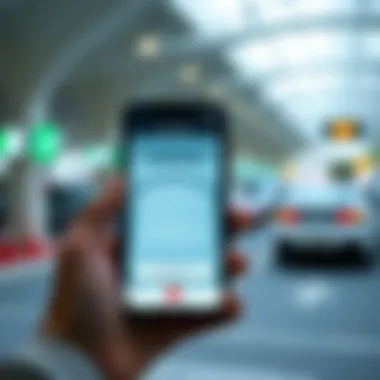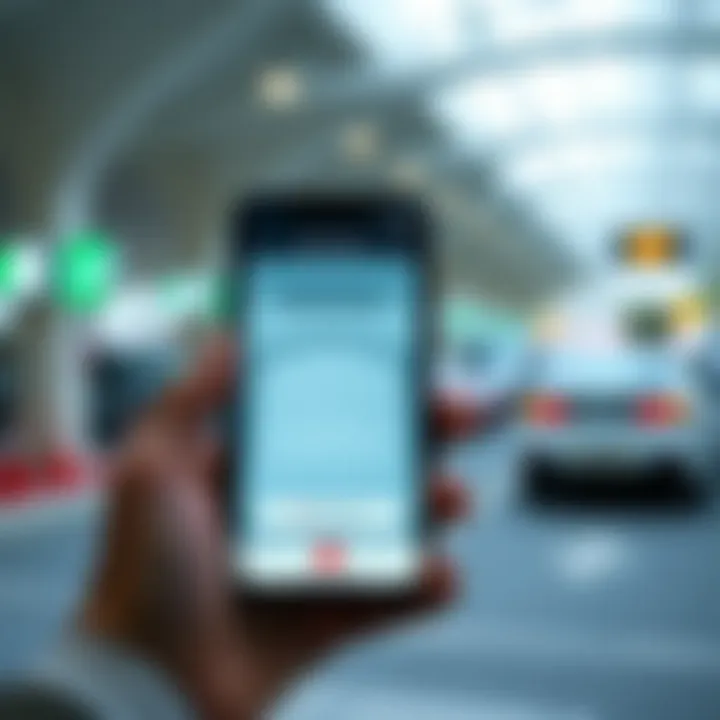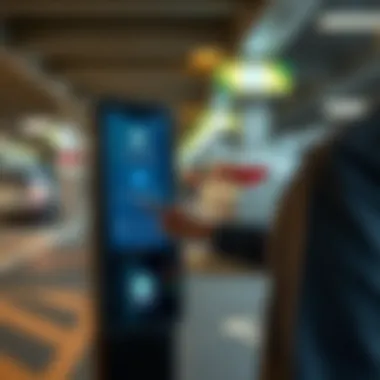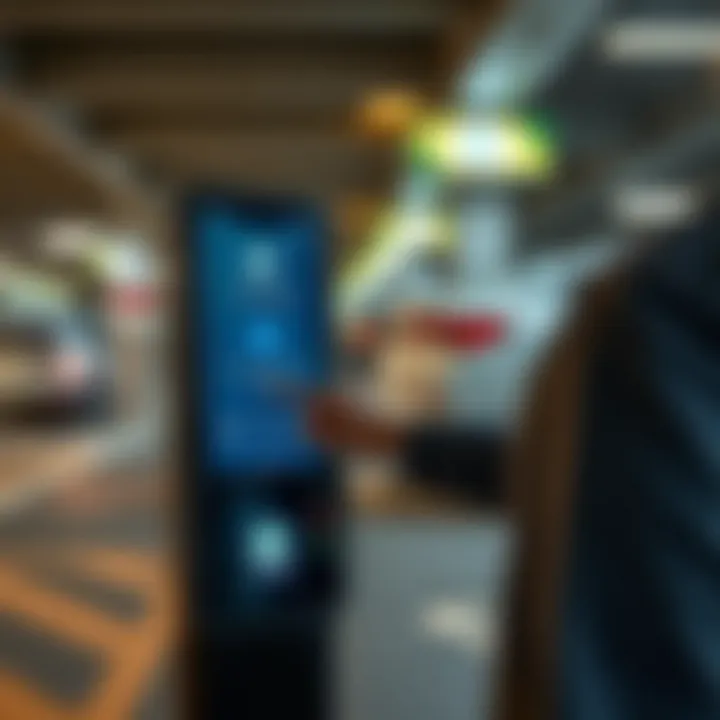Exploring Mobile Parking Innovations in Dubai


Intro
As cities grow, the challenges that come with urban spaces multiply. One of the most pressing concerns is parking. In a bustling metropolis like Dubai, where the landscape is constantly evolving, finding a parking spot can feel like searching for a needle in a haystack. Traditional parking options are often insufficient, leading to congestion, wasted time, and increased frustration among residents and visitors alike. Mobile parking solutions have started to emerge as a beacon of hope in this scenario. These advanced technologies promise not only efficiency but also a more organized and sustainable approach to parking.
In this guide, we take a closer look at the mobile parking solutions available in Dubai, examining their impact on the urban environment and the ways in which they are reshaping the experience of parking in this vibrant city. From the technology driving these innovations to the regulatory frameworks that support them, we'll cover a range of topics that highlight the importance of mobile parking in today’s fast-paced world.
Through a careful analysis of market trends, investment opportunities, and user experiences, we’ll uncover how mobile parking can redefine urban mobility. Whether you are an investor looking to navigate this space or a homeowner seeking smoother daily commutes, understanding mobile parking solutions in Dubai is crucial. Let’s dive in.
Understanding Mobile Parking
In the bustling megacity of Dubai, the need for efficient, user-friendly parking solutions can't be overstated. Mobile parking, in particular, stands out as a crucial facet of urban transport strategy. With the rise of smartphone technology, integrating these systems seamlessly into the daily lives of residents and visitors has become imperative.
The concept revolves around the use of mobile applications to facilitate various parking operations such as locating available spaces, reservations, and payments. Essentially, it flattens the learning curve, making navigation and usage intuitive for people from all walks of life, be they tech-savvy millennials or traditionalists who are just starting to adapt to the digital landscape. The combination of convenience and speed elevates the user experience, making it a sought-after solution in densely populated environments.
Definition and Concept
Mobile parking refers to systems that enable users to manage parking needs through mobile devices. At its core, it integrates technology with user demand; drivers can find a spot using a mobile app, tap a button to reserve it, and complete payment without ever having to step foot near a parking meter. The simplicity inherent in this process cannot be emphasized enough.
For instance, consider how a visitor to Dubai might be overwhelmed by the sheer volume of activity and attractions, from the Dubai Mall to the palm-lined drive at Jumeirah Beach. With mobile parking solutions in play, they can book a parking spot while sipping coffee, alleviating the stress of searching for a space upon arrival.
This shift towards technology doesn’t just cater to comfort—it fundamentally alters how urban mobility is perceived and operationalized. ) It enables a fluid transition between various modes of transport, thereby enhancing overall accessibility.
Importance in Urban Planning
Understanding mobile parking is vital not just from a user perspective but also from an urban planning standpoint. Cities are witnessing unprecedented population growth, leading to increased vehicular density. Urban planners are compelled to consider innovative solutions to maximize space utility and minimize congestion.
Engaging with mobile parking technologies can lead to recommendations for:
- Smart City Integration: By incorporating real-time data from mobile parking apps, urban planners can identify peak traffic spots, adapt to changing trends, and make informed decisions about infrastructure investments.
- Environmental Considerations: Implementing more efficient parking systems contributes significantly to reducing a city’s carbon footprint. If drivers can locate parking quickly and avoid cruising for spaces, emissions will decrease.
- Economic Benefits: Enhanced parking systems often lead to increased commerce and tourism as ease of access brings more visitors, contributing to local economic growth.
“Mobile parking isn't just a service; it’s a key component of evolving urban spaces, enabling a more synchronized relationship between residents, visitors, and a rapidly changing landscape.”
In essence, understanding mobile parking systems is more than an academic interest or a passing trend. It's about rethinking urban environments, fostering community engagement, and elevating the quality of life for citizens across Dubai. With these systems in play, the city can not only alleviate parking woes but can also strategically enhance its infrastructure and appeal as an international hub.
The Evolution of Parking Solutions in Dubai
The landscape of parking solutions in Dubai has seen dramatic changes over the years. With the city’s rapid growth, this evolution has turned parking into a critical issue for urban planning and daily life. Many factors have driven this transformation, making it essential to understand where these solutions began and where they are heading.
Historical Context
In the not-so-distant past, parking in Dubai was fairly rudimentary. Before the 21st century, finding a parking spot often resembled a game of chance, where luck played a larger role than skill. Streets were lined with makeshift parking options, and drivers often relied on their instincts and experience to find a place to leave their cars. As Dubai transformed into a global city, demand for established parking systems grew.
During the early stages of development in the Emirate, the focus was heavily on infrastructure—tall skyscrapers, sprawling mall complexes, and lavish hotels. However, as the population expanded and tourism flourished, complaints about chaotic parking began to surface. It became glaringly apparent that the existing systems weren't just inadequate; they were unsustainable in the long run.
Consequently, authorities started to consider how parking could better integrate with the urban fabric. The Dubai municipality introduced paid parking systems in notable areas, leading to the establishment of multi-story car parks. These facilities aimed to centralize parking spaces while alleviating congestion on roads.
Current Trends
Fast forward to today, and Dubai is witnessing an ongoing transformation of its parking solutions. Thanks to technological advancements, parking is no longer just about finding a spot. Mobile applications have taken the front seat, allowing drivers to spot openings from their phones before they arrive. These apps not only show available spaces but also highlight pricing, enhancing informed choices for users.
In addition, smart sensors installed in parking lots are becoming commonplace, detecting occupied and vacant spaces and relaying this information to apps in real-time. Communicating this data creates a more efficient parking experience for everyone involved. Imagine being able to navigate directly to an available spot without driving around in circles—a dream come true for many.
Moreover, Dubai’s commitment to sustainability has influenced how parking solutions are developed. Efforts aimed at reducing environmental footprints foster ongoing discussions about EV (electric vehicle) charging stations, encouraging eco-friendly transport options.
As we analyze these current trends, it's clear that the journey of parking in Dubai has evolved from chaotic beginnings to a more organized and tech-savvy system. The changes that have taken place demonstrate not only the rapid growth of the city but also how parking solutions are adapting to meet the needs of residents, tourists, and businesses alike.
Tech-savvy parking solutions are reshaping urban mobility, integrating convenience with sustainability.
Overall, understanding the evolution of parking solutions sheds light on broader urban planning strategies and highlights the importance of efficiency and usability in an increasingly busy Dubai.
Technological Advancements Behind Mobile Parking
The essence of modern mobile parking solutions in Dubai largely hinges on cutting-edge technological advancements. Each innovation—be it a mobile application, smart sensors, or new payment systems—contributes not only to enhanced user experience but also to the overall efficiency of urban mobility. Understanding these elements is vital for investors, homeowners, realtors, expatriates, and renters who wish to navigate the increasingly complex landscape of parking in this bustling metropolis.
Mobile Applications
Mobile applications are reshaping the way drivers interact with parking spaces in Dubai. Through intuitive interfaces, these apps allow users to locate, reserve, and pay for parking spots with a few taps on their smartphones. Apps such as RTA Smart Parking not only provide real-time availability but also incorporate features like reminders and navigation assistance.
The benefits of such applications are manifold:


- Convenience: Users can effortlessly manage their parking needs from anywhere, reducing time spent searching for spots.
- Real-Time Updates: Instant notifications about availability and pricing help in making informed decisions.
- User-Friendly Design: A well-designed interface caters to users with various levels of technological proficiency.
Moreover, as mobile applications continue to evolve, the integration of features like augmented reality (AR) for locating parking spots might very well change the game entirely. Imagine pointing your smartphone at a street and instantly seeing available parking slots highlighted, significantly making the parking hunt less stressful.
Smart Sensors and IoT
The proliferation of smart sensors and the Internet of Things (IoT) forms the backbone of efficient monitoring and management of parking spaces. Sensors embedded in parking lots provide real-time data about vehicle presence and availability, helping to optimize space utilization.
Here are some critical elements of smart sensor technology:
- Data Collection: Continuous monitoring enables the collection of data about peak parking times, helping operators make informed decisions regarding space management.
- Automated Findings: Users can get alerts through mobile applications when a spot is vacated, enhancing the likelihood of quick parking resolutions.
- Infrastructure Integration: These smart systems can easily integrate with existing urban infrastructure to streamline operations and communications between devices.
This technology not only simplifies the parking process but also supports environmental initiatives by encouraging efficient space usage, thus reducing congestion and emissions.
Payment Innovations
Innovations in payment systems are crucial in enhancing the user experience within mobile parking platforms. In Dubai, where speed and simplicity are valued, options such as contactless payments, in-app transactions, and multi-currency services cater to a diverse population of drivers.
Here's how these innovations transform the payment landscape:
- Contactless Payments: Systems like Apple Pay or Google Wallet allow users to process payments swiftly, minimizing the handling of cash.
- Flexible Options: Users have the ability to pay by the hour, by day, or even set up subscriptions for regular use; thus accommodating varying parking needs.
- Multi-Currency Support: Given Dubai's international audience, multi-currency options allow seamless transactions for expatriates and tourists alike, enhancing their parking experience.
The amalgamation of these payment innovations into mobile parking apps not only simplifies the process but also increases customer satisfaction, thus aiding in wider acceptance of mobile solutions among various demographics.
Mobile Parking Services in Dubai
Mobile parking services play a significant role in shaping the urban landscape of Dubai. As the city continues to grow rapidly, the demand for seamless and flexible parking solutions becomes increasingly crucial. These services not only ease the struggle of finding parking space but also enhance the overall experience for residents, visitors, and businesses. By leveraging innovative technologies, mobile parking services are changing how individuals approach vehicle parking in the bustling city.
Overview of Available Services
Dubai boasts a variety of mobile parking services that cater to diverse user needs. Here’s a glimpse into what’s available:
- Mobile Apps: Many mobile applications offer real-time information about available parking spots, allowing users to reserve spaces in advance. This can help reduce the time spent driving around in search of parking, thereby lowering stress levels and fuel consumption.
- Payment Solutions: Processes like cashless transactions via apps or contactless payments have streamlined the parking experience. Users no longer need to scramble for coins or deal with old-fashioned machines.
- Reservation Systems: Some services enable users to book parking in advance, ensuring a spot upon arrival. This feature is particularly useful during busy events or peak tourist seasons.
The blend of these elements serves not only to enhance convenience but also to boost user satisfaction by putting the power in the hands of the driver.
Comparative Analysis
Local Vendors
When we talk about local vendors in Dubai's mobile parking scene, they bring an intimate understanding of the city's dynamics to their operations. These vendors often focus on user experience—tailoring their services to meet specific community needs. One of their key characteristics is the integration of personalized customer service, which can’t always be matched by larger corporations.
For instance, local apps often feature insights and tips while parking around various neighborhoods. This can include specialized information about pop-up markets or local events, enhancing the urban experience for users. However, it’s worth noting that while these services can excel in customization and local knowledge, their reach may not be as extensive as international providers.
International Solutions
On the other side of the coin, international solutions typically offer well-developed, comprehensive parking systems backed by advanced technology. A prominent characteristic of these solutions is their widespread standardization, which can be a major advantage for tourists and expatriates.
For example, many of these applications provide multilingual support and user-friendly interfaces that appeal to the diverse demographic of Dubai. They often come equipped with features like automatic license plate recognition, adding an extra layer of convenience. However, local integration might sometimes feel lacking, as they may not always capture the full essence of Dubai’s unique charm or address localized issues effectively.
In summary, whether one opts for local vendors or international solutions, there are distinct advantages and disadvantages to each. Understanding these options can lead to a more informed choice, ultimately enhancing the parking experience in Dubai.
Regulatory Framework Surrounding Mobile Parking
Regulatory frameworks provide the essential structure that supports the development and operation of mobile parking solutions in Dubai. Such frameworks are pivotal as they ensure that these systems are not only efficient but also compliant with local laws and standards. Without proper regulations, the mobile parking market could spiral into chaos, leading to confusion for users and inefficiencies in service delivery.
Government Policies
In Dubai, the government has embraced technological advancements, recognizing them as a key driver for improving urban mobility. The policies surrounding mobile parking reflect this commitment. The local authorities, including the Roads and Transport Authority (RTA), have devised regulations to govern how mobile parking services can operate.
Key aspects of these policies include:
- Licensing Requirements: Companies wishing to offer mobile parking services must obtain the necessary licenses, ensuring only legitimate entities operate within the city limits.
- Pricing Regulations: There are stipulations governing service charges, promoting fair pricing for users. This is vital in a place like Dubai, where both residents and tourists rely heavily on parking services.
- Data Security Protocols: Given the personal and payment information that mobile parking apps handle, regulations mandate strict adherence to data protection laws, safeguarding user privacy.
These policies not only foster a competitive market but also promote innovation through a responsible framework, ensuring a smooth ride for businesses and users alike.
Compliance Requirements
The implementation of mobile parking solutions must align with specific compliance requirements that serve both the users and the city’s infrastructure. Compliance includes engaging with various stakeholders, from local government offices to tech developers and even the public itself.
Some notable compliance aspects include:


- User-Friendly Interfaces: Applications must be designed to cater to all demographics, including individuals with disabilities. This ensures that everyone has access to seamless parking solutions.
- Regular Audits: Mobile parking providers are often subject to periodic audits to assess compliance with regulations, operational effectiveness, and overall service quality.
- Feedback Mechanisms: Policies encourage the establishment of channels for customer feedback, allowing users to report issues or suggest improvements, leading to a more user-oriented service environment.
The adherence to these compliance requirements not only elevates user satisfaction but also contributes significantly to the reliable management of urban spaces in Dubai.
Compliance with the regulatory framework is not just a legal obligation; it's a cornerstone for the future growth and sustainability of mobile parking solutions in Dubai.
Investment and growth in mobile parking technologies hinge on the robustness of this regulatory framework. Following the path set by government policies and compliance requirements, stakeholders can navigate the mobile parking landscape with a degree of assurance and clarity.
User Experience and Accessibility
In the realm of mobile parking solutions, the considerations of user experience and accessibility are vital. As cities evolve, so too does the way their residents and visitors interact with urban spaces. With populations swelling and mobility becoming increasingly complex, a smooth user experience is essential to ensure satisfaction and efficiency. In Dubai, where modernity meets tradition, creating mobile parking solutions that cater to a diverse array of needs becomes even more crucial.
Ease of Use
Navigating mobile parking apps should be as straightforward as locating a parking spot itself. When we talk about ease of use, we're referring to how intuitive these applications are for the person on the street—whether a local or a visitor caught in the hustle and bustle of the city.
Mobile parking solutions today are designed to be user-centric. This means that developers need to ensure that the apps not only function well but are also easy to navigate. An user-friendly interface is paramount; think big buttons, clear layouts, and a logical flow of information. Users should be able to find parking areas, view availability, and make payments within just a few taps. Features like real-time updates on parking space availability are particularly advantageous, as they allow drivers to adjust their routes promptly if an area is fully booked.
Here are some important elements that enhance ease of use:
- Clear Instructions: Step-by-step guides or tooltips are useful for users who may be unfamiliar with the app.
- Quick Registration: Streamlined sign-up processes can help users get started without a hassle.
- Multi-Language Support: Considering Dubai’s multicultural population, offering various language options can make a significant difference.
"The smoother the mobile parking process, the less time drivers spend circling blocks, which means a happier urban environment overall."
Accessibility for All Users
A key aspect of mobile parking systems is ensuring accessibility for all types of users. This doesn't only include proficient tech users; it also encompasses older adults unfamiliar with smart technology, as well as individuals with disabilities who may require special accommodations.
Thinking beyond basic functionality is essential. For instance, it’s important that parking apps are designed with accessibility features, so everyone can make use of them without facing unnecessary barriers. Here are some crucial considerations:
- Voice Commands: Implementing voice-activated features can help those who may have difficulty typing or navigating through menus.
- Visual Accessibility: Apps should integrate high contrast colors, larger fonts, and screen reader compatibility to accommodate users with visual impairments.
- Clear Parking Designations: Ensuring that information on reserved parking for people with disabilities is easily accessible and well displayed helps contribute to an inclusive environment.
Incorporating these accessibility measures not only benefits individuals who might otherwise struggle with technology but also enhances the experience for all users. A parking app that caters comprehensively to its user base can lead to higher satisfaction rates, promoting greater adoption of these systems across Dubai.
The next step forward in mobile parking solutions lies in prioritizing these elements, blending cutting-edge technology with thoughtful design to meet the needs of a diverse urban populace.
Challenges within Mobile Parking Systems
As Dubai continues to grow, embracing modern solutions like mobile parking systems, it faces a variety of hurdles. These challenges can hinder the effectiveness and overall acceptance of parking technologies in the city. Addressing these issues is not just vital for local authorities but also for businesses, residents, and visitors who rely on efficient mobility.
Technical Difficulties
Mobile parking solutions, while innovative, are not without their flaws. Technical issues can arise from software bugs, compatibility problems with different devices, and inadequate infrastructure.
- Software Reliability: A glitchy app can lead to frustrated users, who may end up with parking tickets these inaccuracies might cause. Regular updates and testing are important.
- Device Compatibility: Not all mobile devices operate on the same software. As a result, some users may struggle to access the services if their devices cannot support the app’s features.
- Infrastructure Concerns: The successful implementation of mobile parking relies heavily on the existing infrastructure. If parking meters and sensors are not well integrated, this can lead to confusion and disillusionment among users.
Addressing these issues requires collaboration among software developers, city planners, and user feedback to foster a more reliable parkiong experience.
Public Acceptance
Another pivotal challenge lies in public acceptance of mobile parking systems. Many people have become accustomed to traditional parking methods, and shifting to a new system can be met with skepticism. This hesitance is influenced by several factors.
- Awareness and Education: A lack of information about how mobile parking works can lead to misunderstandings. Educational campaigns can help inform users about the benefits of mobile systems, including convenience and efficiency.
- User Trust in Technology: People often worry about data security and privacy. Concerns about who has access to their information and how it is used can be a significant barrier to acceptance.
- Cultural Habits: In a city like Dubai, where habits and routines are often ingrained, changing behavior takes time. Some individuals may prefer cash transactions and traditional methods.
To gain public trust, stakeholders must demonstrate the advantages and reliability of these solutions. The transition from traditional to modern must be gradual and supported by community involvement.
"Change in behavior, particularly in urban settings, often requires time, awareness, and an understanding of user concerns."
Impact on Urban Mobility and Environment
The significance of mobile parking solutions extends well beyond mere convenience; they play a vital role in reshaping urban mobility and enhancing the environment. As intertwining urbanization and population growth raise the stakes for city infrastructure, embracing innovative parking technologies can lead to substantial improvements. By facilitating more efficient use of space and minimizing environmental impact, mobile parking solutions hold the potential to redefine transportation dynamics in Dubai.
Efficient Space Utilization
In bustling cities like Dubai, available space is at a premium. Efficient space utilization through mobile parking solutions directly addresses this issue. Mobile apps that provide real-time information about parking availability help drivers find open spots quickly, cutting down on lengthy searches that waste valuable time and fuel. This not only eases congestion but also promotes more organized city layouts. When fewer vehicles circle looking for parking, it can significantly decrease traffic flow issues.
Here are several benefits of efficient space utilization:
- Optimized Parking: Mobile solutions allow users to locate parking spots precisely where they need them, reducing the likelihood of parking overflow into residential or unauthorized areas.
- Dynamic Pricing: Flexible pricing models can encourage drivers to park during off-peak hours, allowing for better distribution of vehicles throughout the day.
- Multi-Use Facilities: Many mobile parking applications now support shared spaces, such as using unfenced lots for different purposes at varying times, maximizing the utility of each area.
Adopting these strategies enhances mobility and significantly contributes to the overall functionality of urban environments, making Dubai a better place to live, visit, and do business.


Reduction of Carbon Footprint
Improving urban mobility is not just about convenience; it’s also about sustainability. Mobile parking solutions can help reduce the overall carbon footprint by decreasing vehicle emissions resulting from unnecessary idling and erratic driving patterns. A more structured parking approach facilitates better traffic flow and efficient navigation through city streets, leading to lower fuel consumption.
Transit Integration
Transit integration plays a critical role in facilitating seamless movement within urban ecosystems. By allowing mobile parking applications to connect with public transport networks, users can easily transition from private vehicles to buses or metro systems.
A key characteristic of transit integration is its ability to promote a balanced mix of transportation options. This can lead to a substantial drop in the number of cars on the road, effectively decreasing emissions and fostering a cleaner environment. Another unique feature is the option of real-time updates on public transport schedules, offering users more flexibility and convenience in their journeys. Moreover, this integration is often a beneficial choice since it maximizes the efficiency of travel while minimizing congestion and pollution.
On the downside, challenges remain in ensuring that all systems work smoothly together. If the technology fails or does not accurately reflect real-time conditions, it can disrupt plans and discourage users from switching to public transport.
Parking Policies
Effective parking policies also contribute significantly to the broader goals of urban mobility and sustainability. Establishing regulations that govern the use of parking spaces can promote responsible usage and cultivate an eco-friendly mindset among drivers. Policies can include reduced fees for electric vehicles or incentives for carpooling, encouraging people to explore alternative transport modes.
A defining characteristic of effective parking policies is their ability to adapt and respond to evolving urban needs. By placing limits on how long vehicles can occupy spaces and imposing fines for violations, cities can foster more turnover in available parking spots, promoting widespread use without overcrowding specific areas. For instance, Dubai has started implementing designated parking spots for car-sharing services, which can further enhance efficiency and reduce congestion. This shift reflects a clear beneficial choice in promoting sustainable infrastructure.
However, there are potential downsides, such as possible backlash from drivers who may see these policies as restrictive. It's essential to strike a balance, providing guidelines that promote public interest without alienating users.
"To achieve a sustainable urban future, cities must utilize innovative solutions that not only meet the demands of today but also pave the way for tomorrow."
In summary, the impact of mobile parking solutions on urban mobility and the environment in Dubai is profound and multifaceted. By enhancing efficiency in space use and actively reducing carbon footprints, these systems serve as a cornerstone in the quest for a sustainable urban ecosystem.
Case Studies of Effective Mobile Parking Applications
Exploring mobile parking applications provides invaluable insights into their practical applications and efficacy. Case studies offer a lens through which to view the benefits and challenges of these innovations, particularly in a vibrant city like Dubai. They reveal not only how these applications perform in real-life scenarios but also how they respond to varied user needs and regulatory frameworks.
Local Initiatives
In the realm of local initiatives, Dubai has witnessed several noteworthy applications that shape the parking landscape. For example, the Dubai Parking App—developed by the Road and Transport Authority (RTA)—is an exemplary model of local adaptation. This app allows users to find available parking spots in real-time, make payments seamlessly, and receive notifications on parking durations. The app includes features that cater specifically to the needs of both residents and visitors, thus enhancing their mobility experience.
Another local initiative worth mentioning is the Smart Parking Project at popular shopping destinations like Dubai Mall. This project integrates smart sensors to monitor parking space availability. Through an intuitive mobile interface, users can receive guidance to the nearest vacant spot, significantly reducing time spent searching for parking—a common frustration in busy urban areas. The success of these initiatives not only improves user experience but also feeds into the city's broader sustainability goals by minimizing traffic congestion and emissions.
Global Comparisons
When considering global counterparts, one might look to San Francisco’s ParkMobile application, which has established itself as a frontrunner in mobile parking solutions worldwide. Similar to Dubai’s initiatives, ParkMobile allows for easy payments and real-time space availability updates. However, what stands out is its integration with public transport systems, providing users an all-encompassing view of their travel options. This level of integration presents a compelling case for Dubai's future development.
In Europe, the JustPark app in London offers a unique peer-to-peer model allowing individuals to rent out their driveways or unused spaces. This concept poses an intriguing solution for Dubai, where space is at a premium. The potential for local residents to monetize their property while addressing parking shortages could create a symbiotic relationship beneficial to community members and newcomers alike.
The cross-examination of local and global applications opens doors for innovative solutions that can be tailored to specific urban challenges while learning from successes abroad.
As we examine these case studies, it becomes clear that mobile parking applications are not merely conveniences; they are essential tools that contribute to more efficient urban planning and superior user experiences. With their rapid evolution, these case studies set the stage for future developments in mobile parking solutions, enabling stakeholders—ranging from investors to municipal policymakers—to make informed decisions about the continuing transformation of Dubai's urban environment.
For further insights, consider reviewing relevant resources on urban mobility initiatives at Wikipedia and Britannica.
Overall, local initiatives and global comparisons paint a comprehensive picture of the mobile parking landscape, showcasing how targeted approaches can leverage technology to solve practical issues.
Future Prospects of Mobile Parking in Dubai
The landscape of mobile parking solutions in Dubai is not just a reflection of current technologies but also a glimpse into the future of urban mobility. As the city continues to grow, understanding these future prospects is crucial for investors, realtors, homeowners, expatriates, and renters alike. The insights gained here can impact decisions regarding urban infrastructure, property investments, and daily commuting choices.
Predicted Trends
The coming years are poised to witness several key trends in mobile parking, driven largely by evolving technology and changing user behaviors.
- Increased Integration with Public Transport: One of the most promising trends is the integration of mobile parking apps with public transportation systems. This may allow users to seamlessly plan their journeys, combining parking with bus or metro schedules. Such holistic solutions can significantly reduce vehicle congestion in key areas and ease parking woes in busy districts.
- Real-Time Data Sharing: Expect smarter systems that share live data about available parking spots. These services will not only inform drivers about where to find an open space but also optimize the allocation of these spaces based on usage patterns, enhancing overall efficiency.
- Focus on Sustainability: As cities push for greener initiatives, mobile parking solutions will also evolve to support sustainability. Innovations such as eco-friendly parking spaces, facilitating electric vehicle charging integration, and promoting ridesharing will likely become part of the parking ecosystem.
- Enhanced User Experience through AI: Artificial Intelligence and machine learning will shape future mobile parking applications, providing personalized recommendations based on a user’s past behaviors or preferences. This could lead to faster decision-making and a smoother experience overall.
Potential Innovations
Looking beyond trends, there are several groundbreaking innovations on the horizon that have the potential to redefine how mobile parking operates in Dubai.
- Blockchain for Payment Processing: Utilizing blockchain technology can enhance transaction security and transparency in payment processing for parking. This not only protects users’ financial information but also allows more efficient transfer of payments between vendors and users.
- Augmented Reality (AR) Navigation: Imagine using an app that guides you to your parking spot using AR. Such technology could overlay directions directly onto your smartphone screen, making it almost impossible to miss your turn. This could significantly reduce the time spent searching for spaces and improve driving safety.
- Dynamic Pricing Models: Future mobile parking systems may adopt dynamic pricing strategies that fluctuate based on demand. Price adjustments based on real-time conditions could help manage parking supply, ensuring availability during peak hours while encouraging users to park during off-peak times.
- Wearable Technology Integration: With the rise of wearable devices, linking mobile parking solutions with smartwatches and fitness trackers could become commonplace. This connectivity offers a new avenue for alerts, bookings, or even feedback on parking experiences, directly from the user's wrist.
End
Summary of Findings
- Efficiency at Its Best: The mobile parking systems are designed to alleviate the chronic parking shortages that plague popular areas. By streamlining access to parking spaces through mobile platforms, users find increased availability and reduced time circling around blocks.
- Technological Integration: From AI-assisted applications to real-time data sharing, the backbone of mobile parking revolves around sophisticated tech. These tools give users insights into space availability, payment options, and ease of use.
- Impact on the Environment: Implementing these systems also leads to sustainability benefits. As users spend less time looking for parking, the carbon footprints decrease, contributing to a cleaner urban atmosphere. Integrating public transit more seamlessly into the parking solutions signifies further steps toward an eco-friendly approach, not just a quick fix.
- User-Centric Design: Understanding the user experience has spurred companies to develop interfaces that cater to everyone, from tech wizards to those who might take a bit longer to learn the ropes. Designing for accessibility ensures that everyone can make the most of these advancements.
"Mobile parking solutions are reshaping how we think about urban space, simplifying access and reducing congestion in one sweep."
Final Thoughts
As we navigate the future of mobile parking in Dubai, the implications are vast and far-reaching. Investors and stakeholders must stay attuned to the evolving landscape and the continuous technological advancements that shape our cities. The integration of mobile solutions heralds a new era that prioritizes user experience and efficiency while balancing ecological considerations.
Ultimately, in an increasingly digital world, embracing mobile parking solutions represents a forward-thinking approach that the city cannot afford to overlook. The benefits touch on every aspect of urban living, paving the way for a more organized, accessible, and sustainable future.



